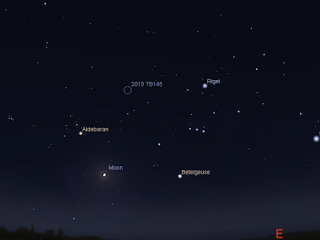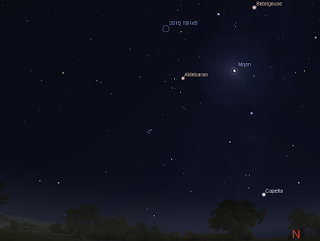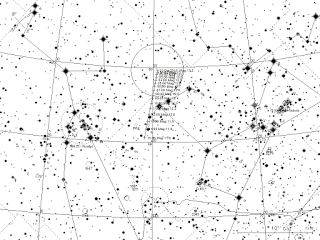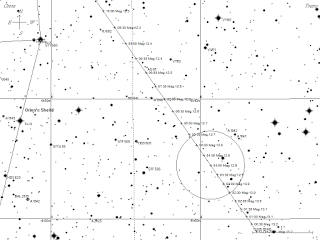| Online: | |
| Visits: | |
| Stories: |

| Story Views | |
| Now: | |
| Last Hour: | |
| Last 24 Hours: | |
| Total: | |
UPDATED: Watching NEO 2015 TB145 from Australia (31 October, 2015)
UPDATED! with charts based on the latest ephemeris.
At this time the asteroid will be a reasonably bright magnitude 10.1, easily visible in small telescopes and strong astronomical binoculars. Unfortunately from Australia we will be unable to see it as it is in the northern sky, only visible from the northern hemisphere.
The asteroid is near Orion's Shield. Tick marks are an 30 minutes apart. Click to embiggen and print. Use the charts up above to orient yourself first.
NEO 2015 TB145 moves from Taurus to Orion, then back into Taurus (crossing the horns of the Bull), into Auriga (where it is brightest) then on to Lynx and beyond.
Australia's best view is on the morning of the 31st, when the asteroid brightens from magnitude 13 to magnitude 12.5. It will be visible in amateur telescopes (as a faint dot), however, the still bright waning Moon 17 degrees away will make it a bit tricky to spot (probably reflectors of 6″ and up are needed, not sure about refractors, the bigger the better). Its movement should be obvious over several minutes in a medium power telescope eyepiece.
The circle is the field of view of a 20 mm eyepiece with a 4″ Newtonian reflector scope. Tick marks are 30 minutes apart. Click to embiggen and print. Use the binocular charts up above to orient yourself first
The asteroid is currently magnitude 16.5, and will not really be accessible to modest amateur equipment until the 30th. You can get an accurate ephemeris for your location from the Minor Planet Ephemeris Centre or JPL horizons. While the orbit is pretty well established, it is still best to wait a few more days to generate an ephemeris as even better position data is gathered.
Stellarium chart showing the location of the asteroid at 4:40 am on 31 October. The chart is in the same orientation and shows most of the same stars, at a slightly different magnification, as the printable chart above. Click to embiggen.
Source: http://astroblogger.blogspot.com/2015/10/updated-watching-neo-2015-tb145-from.html








